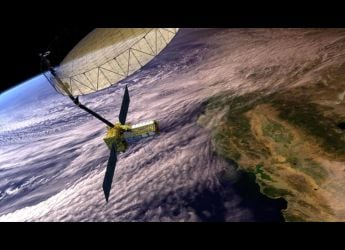- Home
- Science
- Science News
- Colossal Solar Filament Eruption Sculpts 250,000 Mile 'Canyon of Fire' on the Sun’s Surface
Colossal Solar Filament Eruption Sculpts 250,000-Mile 'Canyon of Fire' on the Sun’s Surface
A colossal filament eruption on July 15 left a 250,000-mile glowing rift on the sun’s surface.

Photo Credit: NASA
NASA captures sun’s 250,000-mile-long plasma canyon following powerful filament eruption
On July 15, a massive filament eruption from the sun's northeastern limb exploded in an eye-popping explosion of solar filth and fury, and a bright chunk of it was blown half a million miles into space – a quarter the distance between the Earth and the moon. High-definition video of the event was captured by NASA's Solar Dynamics Observatory (SDO), cutting out the atmosphere as the unstable filament destroyed itself. Ranks of towering walls of plasma, stretching more than 12,400 miles high and more than three times that wide, rose from the wreckage, giving rise to a spectacular “canyon of fire” that temporarily reconfigured part of the sun's surface in a blaze of magnetic rearrangement.
Solar Filament Eruption Triggers CME but Misses Earth, NASA and SOHO Confirm
As per a report by Spaceweather.com, this glowing rift was the result of magnetic field lines violently snapping and realigning after the eruption, leaving behind a scorched trail of plasma. Such filaments, the NASA scientists said, are cooler, denser clouds of solar material that are tethered above the sun's surface by magnetic forces. As these arrangements collapse, they create explosive bursts that sometimes become coronal mass ejections (CMEs), violent clouds of solar plasma that rocket out into space.
The July 15th event did, however, generate a CME, but early observations cut out the Earth. Images from the Solar and Heliospheric Observatory (SOHO) and the GOES-19 satellite indicated the eruption was not directed at Earth. "The front is moving quite slowly and is directed away from the Earth," as noted by aurora observer Vincent Ledvina on social media, based on LASCO and CCOR-1 coronagraph imagery.
These filament eruptions are fundamental blocks in solar activity and forecasts of space weather. While the CME itself is unlikely to disturb Earth's geomagnetic environment, eruptions like these can trigger auroras and interfere with satellite operations during solar storms.
The jaw-dropping video of the eruption provides a stunning example of how the star that powers all known space weather is dynamic and sometimes explosive, and a chance for us Earthly folk to get a look at the enormous forces the sun brings to bear on its skin. Scientists are watching these solar activities to be able to predict more accurately the consequences of such events on the solar system.
For the latest tech news and reviews, follow Gadgets 360 on X, Facebook, WhatsApp, Threads and Google News. For the latest videos on gadgets and tech, subscribe to our YouTube channel. If you want to know everything about top influencers, follow our in-house Who'sThat360 on Instagram and YouTube.
Related Stories
- Samsung Galaxy Unpacked 2025
- ChatGPT
- Redmi Note 14 Pro+
- iPhone 16
- Apple Vision Pro
- Oneplus 12
- OnePlus Nord CE 3 Lite 5G
- iPhone 13
- Xiaomi 14 Pro
- Oppo Find N3
- Tecno Spark Go (2023)
- Realme V30
- Best Phones Under 25000
- Samsung Galaxy S24 Series
- Cryptocurrency
- iQoo 12
- Samsung Galaxy S24 Ultra
- Giottus
- Samsung Galaxy Z Flip 5
- Apple 'Scary Fast'
- Housefull 5
- GoPro Hero 12 Black Review
- Invincible Season 2
- JioGlass
- HD Ready TV
- Laptop Under 50000
- Smartwatch Under 10000
- Latest Mobile Phones
- Compare Phones
- Honor X70
- Realme C71 4G
- Infinix Hot 60 5G+
- Samsung Galaxy Z Flip 7 FE
- Samsung Galaxy Z Flip 7
- Samsung Galaxy Z Fold 7
- AI+ Nova 5G
- Pulse
- Dell 14 2-in-1 Plus
- Dell 16 Plus (AMD, 2025)
- HMD T21 Tablet
- Acer Iconia Tab iM11
- boAt Valour Watch 1 GPS
- Samsung Galaxy Watch 8 (44mm)
- TCL C72K QD Mini‑LED TV
- Haier 43 Inch QLED Ultra HD (4K) Smart TV (43H6E)
- Asus ROG Ally
- Nintendo Switch Lite
- Haier 1.6 Ton 5 Star Inverter Split AC (HSU19G-MZAID5BN-INV)
- Haier 1.6 Ton 5 Star Inverter Split AC (HSU19G-MZAIM5BN-INV)
















